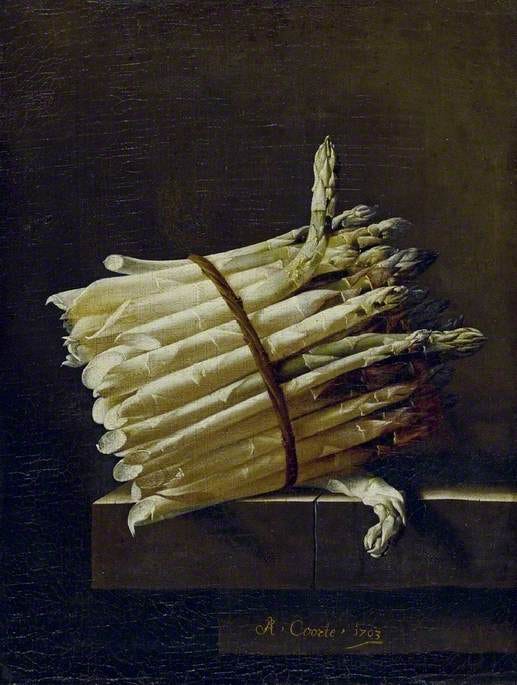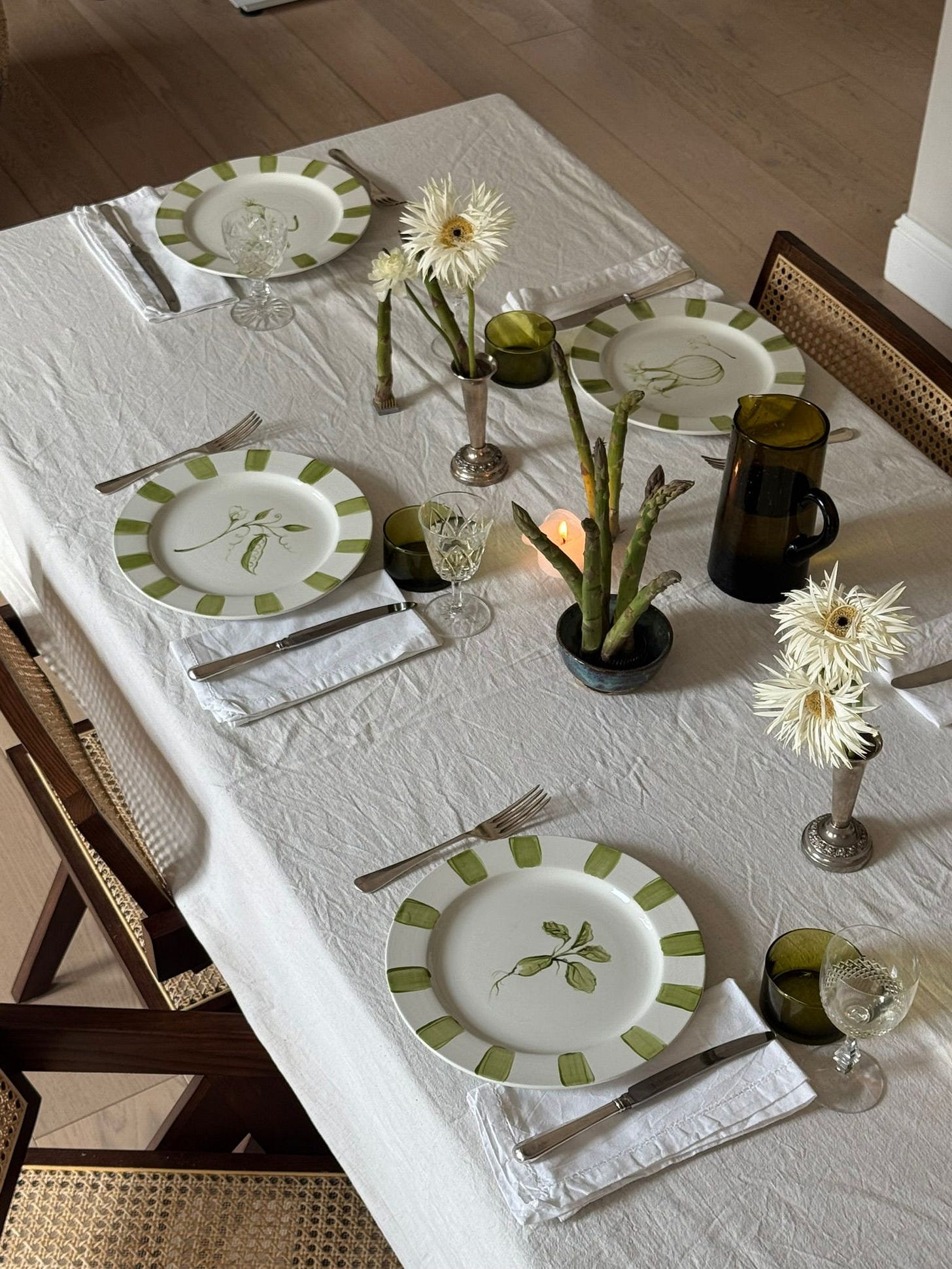A Bundle of Asparagus, Adrien Coorte, 1703. Fitzwilliam Museum, Cambridge
Ten years ago, Googling the words “anatomy of a table” would have resulted in a bunch of diagrams with labels like “top leaf”, “leg”, “foot” and “X stretcher”. This is, woefully, still the case — the search bar has a way of falling behind the times, as evidenced by the fact that when you start typing ‘the white…’, the first result is not ‘the white lotus’ but ‘the white company’. Welcome back to 2008.
If Google didn’t suffer such a geriatric defect, searching for “anatomy of a table” in 2025 would likely yield something different. Indeed, if you ask the far more modern ChatGPT, it senses that you might be interested in the table as an idea more than as an object. Since so many people are using the chatbot for therapy (a huge waste of water and energy resources, by the by), it seems only natural that it should develop an affinity for the abstract.
The table is, certainly, a four-legged object on which to serve food: but it is, more importantly, an extension of the person using it — whether as a makeshift desk or a dining apparatus or anything in between. The same way that we write about painters losing it according to the aesthetic evolution of their oeuvre, the curation of a surface that serves far more than just food — vibes, tea, ideas — is now a metonym for where a person’s head is at.
Did I just compare tablescaping to timeless art? Perhaps I did.
What you’re really looking for when you Google anatomy of a table is advice on how to make your table a TABLE. One that reflects you — or at least reflects the version of yourself you wish to show the world. How to zhuzh the whole thing. How to style and decorate the leaves into something that sends a message, like “I care”. Or, “actually, I don’t”.
I, like Google, have been found to suffer from early onset geriatrics. Having danced the night away once too many in my early twenties, I have now reached the ripe age of 28 and swapped club nights for dinner parties and double vodka lime sodas for hand-poured candlesticks. My biggest weekly card payment now goes to my local florist.
Tablescapes, meanwhile, have become my bread and butter in every sense. I quit my job in television last summer to focus entirely on content creation. (Gauche, I know.) But with fashion houses turning to monogrammed butter-on-toast invitations and brand launches evolving into excuses for artfully placed crudités, it seems the rest of the world at large has gone mad for what I do (not me, specifically, but people like me). Without wanting to flaunt my premonitory instincts, I think I might have been, erm, on the money.
As the vogue for microtrends continues to subside, the art of tablescaping has codified around one, salient element: the mismatch. It's a fine line between a clash and a confluence of colours — between the impeccably gauche (compliment) and the mistakenly gaudy (derogatory) — and as summer beckons and the gardens enter full bloom, I hope this guide will help you tell the difference.
1. Crumpled is Chic
Every great painting starts with a blank canvas, and when it comes to gauche tablescaping, an effortlessly strewn linen is key.
I’ve had some entertaining complaints in my time — generally from 50-something keyboard warriors — about the state of the tablecloth at my dinners. "You need to learn to use an iron" and "Iron your tablecloth. Aggressive full stop." were probably the most direct pieces of advice I received on one particular video.
What I resisted saying to these thoughtful Karens was this: crumpled is chic. Get that neutral H&M linen blend, crumple it into a ball, and crumple it some more. Voilà — the perfect table base. (Dear readers, please know I am completely sincere about this. There is honestly nothing worse than the grid-like remnants of a once-ironed tablecloth that's spent too long folded on the linen shelf.)
2. Mismatch is Cool
Hosting is all about the illusion of effortlessness. From the homely pot of six-hour-cooked ragu left performatively simmering on the hob, to the breezy way you throw open the front door: never let on how much work it all was.
This ethos extends — naturally — to the way you lay the table. While I’m all for a complete set of dinner plates (I’d be doing my own ceramics line a disservice by suggesting otherwise), when it comes to serving vessels, cutlery and utensils, a mismatch is unequivocally cool.
Whether it’s a bargain piece of vintage china, an inherited bowl with too many chips to count, or just a couple of those hip stainless-steel coupes you spent way too much on via Etsy, the more variety on the table, the merrier.
The same goes for cutlery: there’s something immensely charming about a shortage of knives (it makes the meal feel simultaneously more informal and more celebratory). Throw that mishmash of silverware together, laugh about sharing spoons, and don’t feel bad about asking guests to keep their forks for mains.
3. Food Can Be Flowers — and Vice Versa
Recently, strapped for time and not feeling up to my usual quest to the local florist, I transformed a lunch table with a bunch of neglected asparagus rescued from the fridge drawer (see picture above). I stuck some spears in bud vases, propped others between pillar candles, and scattered the rest down the length of the table.
The result? A charming and economical spring alternative to a bunch of parrot tulips, which you then have the joy of eating with your dippy eggs the next morning.
The same goes for flowers in your food. Liven up a salad with a scattering of tulip petals; lean into the gauche with a starburst of daisies in your whipped butter. Just make sure you check they’re edible first.*
4. Have Fun With It
The final — and most important — rule of gauche tablescaping is simple: have some fun with it.
Cook something you’ve never tried before. Make the centrepiece an edible starter. Mix Granny’s hand-me-down Churchill Blue Willow plates with butter-yellow plastic picnicware.
Just, for God’s sake, don’t iron that tablecloth.
*No responsibility will be taken for foolish consumption of inedible plants.










